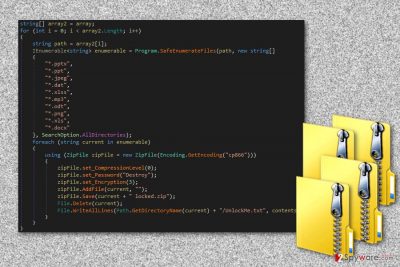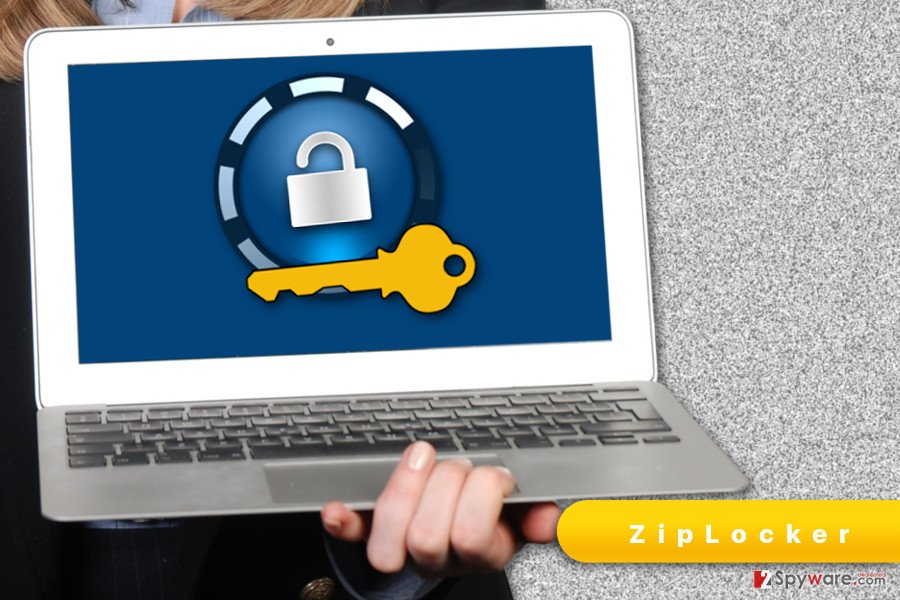ZipLocker ransomware / virus (Easy Removal Guide) - Quick Decryption Solution
ZipLocker virus Removal Guide
What is ZipLocker ransomware virus?
ZipLocker ransomware virus puts targeted files to zip file
ZipLocker ransomware is a new crypto-malware that uses an unusual data encryption strategy. Instead of using traditional AES or RSA ciphers,[1] it zips all the files into a ZIP archive and protects it with a password. Also, encrypted files are renamed using this scheme: [original_file_name]+ locked.zip. Just like many file-encrypting viruses, this one also aims at the most popular file types such as MS Word, OpenOffice, different picture, audio or video formats. In this way, authors of the ransomware hope to cause huge damage to computer users and expect to receive ransoms easily. Following data encryption, ZipLocker drops a ransom note called “UnlockMe.txt.” However, following their instructions is not recommended. Currently, victims can use a password “Destroy” and unlock their files for free. However, data recovery is not the only important task that people need to focus on. It’s crucial to remove ZipLocker from the device as well. Malware might open the backdoor to other cyber infections or encrypt new files. Thus, scan your device with FortectIntego or other reputable security software, and get rid of this cyber infection.

Cyber criminals may change the password or use more sophisticated encryption strategy in the future. However, if the password does not work, you should not consider paying the ransom. Your attempts to obtain the unlock key might end up not only with disappointment and money loss. Transferring demanded sum of money may not guarantee that crooks will provide you a necessary password.[2] They might simply disappear or ask for more money by threatening to delete your files. We cannot assure that hackers are unable to cause such damage, but we can recommend avoiding having business with them. If you have data backups, you can restore at least some of your files from them after ZipLocker removal. What is more, numerous alternative data recovery methods might help you as well.

Ransomware is distributed using various techniques
One of the most popular ways to spread ransomware is malicious email attachments. Thus, ZipLocker ransomware might be hidden in one of the spam emails that are waiting for you in the inbox. Such emails can pretend to be sent from governmental institutions, online shops, banks or other well-known companies. The attached “important” file usually is obfuscated word or PDF document, and clicking on it installs malware executable on the system. However, it’s not the only way how file-encrypting virus might enter the system. ZipLocker virus might be hidden under malware-laden ad or software update or download. Thus, when you click on eye-catchy ads, you should always evaluate the risk because dangerous advertisements might be placed on legitimate sites as well. As you can probably understand, if you want to avoid ransomware, you should be extremely careful and do not trust everything you see online. [3] Always think twice, double-check the information, and strengthen your computer’s security with a reputable antivirus program.
ZipLocker removal instructions
The only safe way to remove ZipLocker from the device is to employ a professional and powerful malware removal program. File-encrypting viruses often inject malicious codes into legitimate system processes, so, it’s manual removal might be complicated and end up with system damage. Thus, we highly recommend scanning the infected device with such programs as FortectIntego, Malwarebytes or SpyHunter 5Combo Cleaner. However, ZipLocker removal may not be as simple as you might think. Malware can prevent you from installing, updating or running security program. For this reason, you may need to disable the virus first, and only then install or access your chosen program. The instructions below will help you to deal with such obstacles.
Getting rid of ZipLocker virus. Follow these steps
Manual removal using Safe Mode
If you cannot perform automatic ransomware removal, reboot your PC to the Safe Mode with Networking and try again.
Important! →
Manual removal guide might be too complicated for regular computer users. It requires advanced IT knowledge to be performed correctly (if vital system files are removed or damaged, it might result in full Windows compromise), and it also might take hours to complete. Therefore, we highly advise using the automatic method provided above instead.
Step 1. Access Safe Mode with Networking
Manual malware removal should be best performed in the Safe Mode environment.
Windows 7 / Vista / XP
- Click Start > Shutdown > Restart > OK.
- When your computer becomes active, start pressing F8 button (if that does not work, try F2, F12, Del, etc. – it all depends on your motherboard model) multiple times until you see the Advanced Boot Options window.
- Select Safe Mode with Networking from the list.

Windows 10 / Windows 8
- Right-click on Start button and select Settings.

- Scroll down to pick Update & Security.

- On the left side of the window, pick Recovery.
- Now scroll down to find Advanced Startup section.
- Click Restart now.

- Select Troubleshoot.

- Go to Advanced options.

- Select Startup Settings.

- Press Restart.
- Now press 5 or click 5) Enable Safe Mode with Networking.

Step 2. Shut down suspicious processes
Windows Task Manager is a useful tool that shows all the processes running in the background. If malware is running a process, you need to shut it down:
- Press Ctrl + Shift + Esc on your keyboard to open Windows Task Manager.
- Click on More details.

- Scroll down to Background processes section, and look for anything suspicious.
- Right-click and select Open file location.

- Go back to the process, right-click and pick End Task.

- Delete the contents of the malicious folder.
Step 3. Check program Startup
- Press Ctrl + Shift + Esc on your keyboard to open Windows Task Manager.
- Go to Startup tab.
- Right-click on the suspicious program and pick Disable.

Step 4. Delete virus files
Malware-related files can be found in various places within your computer. Here are instructions that could help you find them:
- Type in Disk Cleanup in Windows search and press Enter.

- Select the drive you want to clean (C: is your main drive by default and is likely to be the one that has malicious files in).
- Scroll through the Files to delete list and select the following:
Temporary Internet Files
Downloads
Recycle Bin
Temporary files - Pick Clean up system files.

- You can also look for other malicious files hidden in the following folders (type these entries in Windows Search and press Enter):
%AppData%
%LocalAppData%
%ProgramData%
%WinDir%
After you are finished, reboot the PC in normal mode.
Remove ZipLocker using System Restore
System Restore method also helps to disable the virus and run system scan with reputable malware removal program.
-
Step 1: Reboot your computer to Safe Mode with Command Prompt
Windows 7 / Vista / XP- Click Start → Shutdown → Restart → OK.
- When your computer becomes active, start pressing F8 multiple times until you see the Advanced Boot Options window.
-
Select Command Prompt from the list

Windows 10 / Windows 8- Press the Power button at the Windows login screen. Now press and hold Shift, which is on your keyboard, and click Restart..
- Now select Troubleshoot → Advanced options → Startup Settings and finally press Restart.
-
Once your computer becomes active, select Enable Safe Mode with Command Prompt in Startup Settings window.

-
Step 2: Restore your system files and settings
-
Once the Command Prompt window shows up, enter cd restore and click Enter.

-
Now type rstrui.exe and press Enter again..

-
When a new window shows up, click Next and select your restore point that is prior the infiltration of ZipLocker. After doing that, click Next.


-
Now click Yes to start system restore.

-
Once the Command Prompt window shows up, enter cd restore and click Enter.
Bonus: Recover your data
Guide which is presented above is supposed to help you remove ZipLocker from your computer. To recover your encrypted files, we recommend using a detailed guide prepared by 2-spyware.com security experts.If your files are encrypted by ZipLocker, you can use several methods to restore them:
Data Recovery Pro might restore files locked by ZipLocker ransomware virus
Data Recovery Pro is a professional software that helps to restore deleted, corrupted and some of the encrypted files.
- Download Data Recovery Pro;
- Follow the steps of Data Recovery Setup and install the program on your computer;
- Launch it and scan your computer for files encrypted by ZipLocker ransomware;
- Restore them.
Windows Previous Versions feature helps to recover individual files
You can take advantage of Windows Previous Versions feature if System Restore functions has been enabled before ransomware attack. Otherwise, this method is not valid.
- Find an encrypted file you need to restore and right-click on it;
- Select “Properties” and go to “Previous versions” tab;
- Here, check each of available copies of the file in “Folder versions”. You should select the version you want to recover and click “Restore”.
ShadowExplorer – another data recovery tool
If ZipLocker ransomware did not delete Shadow Volume Copies of the targeted files, ShadowExplorer might be helpful in data recovery.
- Download Shadow Explorer (http://shadowexplorer.com/);
- Follow a Shadow Explorer Setup Wizard and install this application on your computer;
- Launch the program and go through the drop down menu on the top left corner to select the disk of your encrypted data. Check what folders are there;
- Right-click on the folder you want to restore and select “Export”. You can also select where you want it to be stored.
ZipLocker decryptor
In order to unlock files, you need to enter the password “Destroy.” If it’s not working, please try additional recovery methods presented above, and do not pay the ransom to cyber criminals!
Finally, you should always think about the protection of crypto-ransomwares. In order to protect your computer from ZipLocker and other ransomwares, use a reputable anti-spyware, such as FortectIntego, SpyHunter 5Combo Cleaner or Malwarebytes
How to prevent from getting ransomware
Choose a proper web browser and improve your safety with a VPN tool
Online spying has got momentum in recent years and people are getting more and more interested in how to protect their privacy online. One of the basic means to add a layer of security – choose the most private and secure web browser. Although web browsers can't grant full privacy protection and security, some of them are much better at sandboxing, HTTPS upgrading, active content blocking, tracking blocking, phishing protection, and similar privacy-oriented features. However, if you want true anonymity, we suggest you employ a powerful Private Internet Access VPN – it can encrypt all the traffic that comes and goes out of your computer, preventing tracking completely.
Lost your files? Use data recovery software
While some files located on any computer are replaceable or useless, others can be extremely valuable. Family photos, work documents, school projects – these are types of files that we don't want to lose. Unfortunately, there are many ways how unexpected data loss can occur: power cuts, Blue Screen of Death errors, hardware failures, crypto-malware attack, or even accidental deletion.
To ensure that all the files remain intact, you should prepare regular data backups. You can choose cloud-based or physical copies you could restore from later in case of a disaster. If your backups were lost as well or you never bothered to prepare any, Data Recovery Pro can be your only hope to retrieve your invaluable files.
- ^ AES and RSA Encryption. Boxcryptor. Encryption software to secure cloud files.
- ^ Christian Cawley. 5 Reasons Why You Shouldn’t Pay Ransomware Scammers. MakeUseOf. The website about technology and gadgets.
- ^ Alexander Ivanyuk. How to Avoid Ransomware: A Few Simple Tips. Acronis blog. Modern data protection, backup and mobility made simple.





















